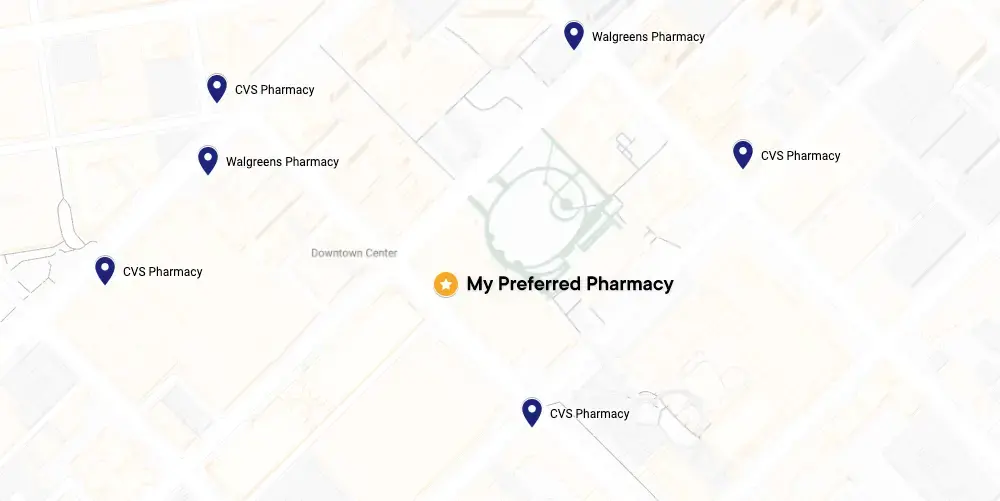%203_2.webp?width=1600&height=1067&name=Qelbree%20(viloxazine)%203_2.webp)
Qelbree (viloxazine) online: non-stimulant ADHD medication
Qelbree (viloxazine hydrochloride) is a non-stimulant ADHD medication approved to treat ADHD symptoms, including inattention, hyperactivity, and impulsivity, in both adults and children aged 6 - 17. Qelbree is a beneficial option for those who are sensitive to stimulants or prefer alternative options. Connect with our doctors online today and explore the possibilities that Qelbree brings to your ADHD management.*
*Prescriptions are provided at the doctor’s discretion. Learn more about our controlled substances policy. Treatment of ADHD will depend on the individual's symptoms, age, and the severity of impact. Prescription medication is a common form of treatment for ADHD. Treatment is most effective when medication therapy is combined with behavioral strategies.
How does Qelbree (viloxazine) work?
Qelbree belongs to a class of antidepressants called selective norepinephrine reuptake inhibitors (SNRIs). Unlike stimulant medications commonly prescribed for ADHD (attention deficit hyperactivity disorder), Qelbree does not directly affect dopamine levels. Instead, it primarily targets the reuptake of norepinephrine, a neurotransmitter or brain chemical associated with attention and focus. By acting on norepinephrine, Qelbree can enhance attention and cognitive function.
Qelbree was FDA-approved for the treatment of both children and adults in April of 2021. Qelbree is not classified as a controlled substance, making it easier to prescribe and manage as it has a low risk of abuse or overdose. The time it takes for Qelbree to take effect varies from person to person, so it’s important to schedule regular follow-up appointments with your doctor.
The benefits of seeing an online doctor for ADHD
Scheduling a virtual doctor visit offers a convenient and flexible solution for managing ADHD. Telemedicine provides easy access to medication management, regular monitoring, and follow-up care from the comfort of your home. Online doctor appointments are particularly beneficial for those with time management challenges, as our doctors are available on weekdays or weekends, day or night. At PlushCare, we strive to make your ADHD care efficient and comfortable.
Qelbree compared to other ADHD medications
Unlike stimulant ADHD medications, such as Adderall, Ritalin, and Vyvanse, Qelbree (viloxazine) is a non-stimulant drug. Stimulant medications like methylphenidate and amphetamine-based drugs have been the go-to treatment for ADHD for many years. They work by increasing levels of certain neurotransmitters, such as dopamine and norepinephrine, in the brain.
As a non-stimulant, Qelbree works differently by modulating norepinephrine without acting on dopamine. Both Qelbree and stimulant medications can effectively manage ADHD symptoms. However, every individual may respond differently to a medication.
Your doctor will help you decide which medication is best for you, depending on your medical history, tolerance to side effects, and specific symptoms. If you have questions about ADHD medications, scheduling a virtual doctor's appointment with one of our board-certified primary care physicians is easy.
Qelbree vs. Strattera (atomoxetine)
Qelbree comes in an extended-release form, so it is taken just once a day. Strattera may be taken once or twice daily, depending on the recommended dose. Qelbree can be taken out of the capsule and added to pudding or applesauce, making it easier for those with trouble swallowing capsules. Strattera must be taken in capsule form.
Qelbree vs. Adderall
Qelbree, as a non-stimulant medication, can be an effective alternative for ADHD patients who are not suitable candidates for Adderall or other stimulant medications. It is important to note that our doctors do not prescribe controlled substances, such as Adderall.
Qelbree vs. Vyvanse (lisdexamfetamine)
Non-stimulant ADHD medications like Qelbree are effective options when stimulant drugs aren’t a good choice. In some patients with ADHD, stimulant medications either don't work or cause intolerable side effects. Stimulant medications might also make other disorders, such as anxiety, worse. There’s also the risk of stimulant drugs being abused, which is especially concerning in patients with a history of substance abuse. Our doctors at PlushCare do not prescribe Vyvanse or other controlled substances.
Qelbree vs. Ritalin
Like all stimulants, Ritalin carries the potential side effects and risks of a controlled substance. As a newer non-stimulant medication, Qelbree offers an effective alternative to treat ADHD.
Studies on Qelbree: what is the success rate of viloxazine?
In children, three separate trials demonstrated improvement in challenging behaviors related to ADHD within six weeks. (1) In some cases, patients experienced reduced ADHD symptom scores as early as the first week. The studies assessed changes in ADHD symptoms, including inattention, hyperactivity, and impulsivity, over six to eight weeks, demonstrating significant symptom reduction compared to a placebo.
Physicians reported that adults who received Qelbree (viloxazine) experienced more significant improvements compared to the placebo group. Patients reported improvement each week during the trial, culminating in a 41% reduction in symptoms compared to a 32% reduction in the placebo group. (5) The randomized, placebo-controlled trial covered flexible doses between 200-600 mg per day. (6)
The studies also showed a low incidence of side effects. Notably, most side effects observed did not lead to the discontinuation of Qelbree treatment. Qelbree, available in capsule form, is not a controlled substance, and there is no evidence of its abuse. The convenient once-a-day dosing helped with patient compliance.
Qelbree and antidepressants
As a relatively new drug, Qelbree is still being studied for potential interactions with the many antidepressants that are on the market. Qelbree functions as an SNRI antidepressant, and there are added risks in combining any antidepressant drugs for mental health treatment.
In particular, antidepressants that belong to the class of drugs monoamine oxidase inhibitors (MAOIs), as well as certain asthma medications, should not be taken with Qelbree.
Qelbree and Lexapro (escitalopram)
Qelbree and Prozac (fluoxetine)
Qelbree dosing information and usage guidelines
Your doctor will recommend the Qelbree dosage most suitable for you. The recommended dosage of Qelbree (viloxazine extended-release) can vary based on individual factors, including age, weight, and the severity of ADHD symptoms. Qelbree is available in capsule form with different strengths, including 100 mg,150 mg, and 200 mg. The initial dose may be as low as 100 mg and can be titrated upward based on the individual's response to the medication. The maximum recommended dosage for Qelbree is 600 mg once daily.
Dosing information
Any changes to your dosage should be made under the guidance of your doctor. A Qelbree dosage chart may illustrate the titration schedule, ensuring a gradual increase to the target dose. For example, a starting dose might be 100 mg once daily, with subsequent increases (e.g., 100 mg, 150 mg, and 200 mg) over several weeks.
Instructions on how to take Qelbree
Always take Qelbree as instructed by your physician. Here are some general guidelines:
-
Take Qelbree 1 time each day with or without food.
-
Swallow the capsules whole. Do not cut, crush, or chew the capsules.
-
If the capsules cannot be swallowed whole, the capsule may be opened and the entire contents sprinkled onto a teaspoonful of applesauce or pudding. Swallow all the applesauce or pudding mixture right away, without chewing, or within 2 hours of mixing with applesauce or within 15 minutes of mixing with pudding. Do not chew the applesauce or pudding mixture. Do not store the applesauce or pudding mixture.
What are the pros and cons?
Qelbree
Cons
-
Possible adverse effects: Qelbree, like any medication, may be associated with both mild and severe side effects, including the risk of suicidal thoughts or ideation in rare cases. There are reports of increased heart rate and blood pressure, especially in children under the age of 18, and in-person cardiology evaluation may be needed if worrisome symptoms occur.
-
Cost and insurance coverage: The cost of Qelbree and the availability of insurance coverage may present challenges depending on your insurance provider. Discuss affordability concerns with your doctor, as they may prescribe alternatives or have other solutions. Qelbree remains brand-name-only, without a generic alternative, and the cash price can be more than $300 a month without insurance. With insurance and manufacturer's coupons, the monthly cost can be as low as $20 a month. To determine if your insurance helps cover the cost of Qelbree, check with your insurance plan.
-
Limited long-term data: Qelbree is a relatively new medication, so there is limited long-term efficacy and safety data available. The ongoing monitoring and data collection are essential to further understand its potential effects over an extended period.
Qelbree (viloxazine) side effects and precautions
Common side effects associated with Qelbree may include mild reactions such as changes in appetite, fatigue, sleepiness, nausea, and abdominal pain.
Specific side effects of Qelbree may vary between children and adults. Children may experience side effects such as increased heart rate or blood pressure, decreased appetite, weight loss, insomnia, and irritability. On the other hand, adults may experience side effects like headaches, constipation, migraines, nausea, sleepiness, and irritability.
Allergic reactions
Rarely, Qelbree could potentially trigger a severe allergic reaction, with symptoms such as rash, itching, or swelling, particularly in the face, tongue, or throat. Other potential side effects to watch out for are severe dizziness and difficulty breathing. Get emergency medical help immediately if you notice these potentially life-threatening symptoms.
Some side effects may subside over time as the body adjusts to the medication, while others may worsen. As with any medication, always talk to your doctor right away if you notice any concerning side effects or reactions.
Black box warning: increased risk of suicidal thoughts
There’s an increased risk of suicidal thoughts or behavior in people using Qelbree, particularly in the initial phase of treatment or when doses are adjusted. This risk has been reported in all age groups, including children, adolescents, and young adults.
Anyone beginning treatment with Qelbree or encountering dosage changes should be closely monitored for any signs of unusual changes in behavior, thoughts of self-harm, or suicidal tendencies. If any concerning symptoms arise, seek immediate medical attention right away.
Mania or hypomania in patients with bipolar disorder
Using Qelbree may increase the risk of inducing manic or hypomanic episodes, especially in patients with a pre-existing diagnosis of bipolar disorder. Careful assessment is particularly important for anyone with a history of bipolar disorder.
A prescribing doctor will thoroughly evaluate patients for a history of bipolar disorder or any signs of manic or hypomanic symptoms before prescribing Qelbree. If any such symptoms occur during treatment, seeking prompt medical attention is critical.
Drowsiness or fatigue
Qelbree may also cause drowsiness or a general sense of tiredness or lack of energy. Be cautious when performing tasks or doing things requiring attention until you know how this medication affects you. Don't drink alcohol while taking this medication because it can make sleepiness and dizziness worse.
Pregnancy and breastfeeding
Qelbree may cause harm to a developing fetus and is not recommended for use by women who are pregnant or may become pregnant. It is not known if Qelbree can enter breast milk, therefore the risks and benefits of treatment while breastfeeding need to be discussed with your doctor.
Liver interactions
Periodic monitoring of liver function is advisable during Qelbree treatment. Any signs of liver problems, such as persistent nausea, vomiting, or jaundice, should be reported to your doctor immediately.
Drug and supplement interactions
Qelbree is a relatively new drug and hasn’t been completely studied in terms of interactions, so it’s imperative to inform your doctor about all medications, including prescription and over-the-counter drugs, as well as herbal supplements.
MAOIs
Avoid taking Qelbree in combination with monoamine oxidase inhibitors (MAOIs) due to potential interactions. A 14-day gap is recommended when transitioning between Qelbree and MAOIs to prevent adverse effects.
Qelbree FAQs
How long does Qelbree stay in your system?
How long does it take Qelbree to work?
Does Qelbree give you energy?
Does Qelbree make you tired?
Does Qelbree help with anxiety?
Can you just stop taking Qelbree?
How to get Qelbree online

Book an appointment to discuss Qelbree.

Talk to your doctor online about your ADHD symptoms.

Pick up your Qelbree medication, if prescribed.
Prescriptions are provided at the doctor's discretion. We can send prescriptions to any local pharmacy.
How to talk to your doctor about Qelbree: helpful questions to ask
Managing ADHD can be challenging. At Plushcare, our priority is making sure you receive the information and advice you need when making decisions about your treatment plan. During your telemedicine appointment or visit with your local doctor, here are some questions that may be helpful to ask:
-
How is Qelbree different from stimulant ADHD meds?
-
What are the potential side effects of Qelbree, and how can I manage them?
-
Are there other treatment options available?
-
Will this treatment interact with any other medications I’m taking?
-
Do you recommend therapy alongside medication?
-
What are the results I can expect from taking Qelbree?
-
What should I do if I experience side effects?
-
Are there any groups or resources you would recommend for people with ADHD?
-
How will we track how the treatment is working?
Qelbree pricing details
30 days of free membership
- Same-day appointments 7 days a week
- Unlimited messages with your Care Team
- Prescription discount card to save up to 80%
- Exclusive discounts on lab tests
- Free memberships for your family
- Cancel anytime
Paying with insurance
Membership
$19.99
First month free
Visits
Copay
Visit price with insurance
Often the same as an office visit. Most patients with in-network insurance pay $30 or less!
We accept these insurance plans and many more:



Paying without insurance
Membership
$19.99
First month free
Visits
$129
Visit price without insurance
Frequent Mental Health Searches
Qelbree resources
Sources:
PlushCare is dedicated to providing you with accurate and trustworthy health information.
-
Qelbree. "Results with Qelbree" Accessed on December 17, 2023 at https://www.qelbree.com/pediatrics/adhd-treatment-with-qelbree
-
National Center for Biotechnology Information. “Viloxazine for the Treatment of Attention Deficit Hyperactivity Disorder” Accessed on December 17, 2023 at https://www.ncbi.nlm.nih.gov/pmc/articles/PMC9501833
-
FDA. Accessed on December 17, 2023 at https://www.accessdata.fda.gov/drugsatfda_docs/label/2022/211964s003lbl.pdf
-
Frontiers. Accessed on December 17, 2023 at https://www.frontiersin.org/articles/10.3389/fpsyt.2021.789982/full
-
Qelbree: "ADHD Treatment with Qelbree." Accessed on December 17, 2023, at https://www.qelbree.com/adults/adhd-treatment-with-qelbree.
-
National Center for Biotechnology Information. Accessed on December 17, 2023 at https://www.ncbi.nlm.nih.gov/pmc/articles/PMC9328182/32
-
National Center for Biotechnology Information. Accessed on December 17, 2023 at https://www.ncbi.nlm.nih.gov/pmc/articles/PMC10374479/
-
AAFP. “Viloxazine (Qelbree) for ADHD” Accessed on December 17, 2023 at https://www.aafp.org/pubs/afp/issues/2023/0300/steps-viloxazine-adhd.html
-
Dailymed. Accessed on December 17, 2023 at https://dailymed.nlm.nih.gov/dailymed/fda/fdaDrugXsl.cfm
-
National Center for Biotechnology Information. Accessed on December 17, 2023 at https://www.ncbi.nlm.nih.gov/pmc/articles/PMC9680847/
-
National Center for Biotechnology Information. Accessed on December 17, 2023 at https://www.ncbi.nlm.nih.gov/pmc/articles/PMC9328182/
-
National Center for Biotechnology Information. Accessed on December 17, 2023 at https://www.ncbi.nlm.nih.gov/pmc/articles/PMC9501833/
-
National Center for Biotechnology Information. Accessed on December 17, 2023 at https://www.ncbi.nlm.nih.gov/books/NBK576423/
-
National Center for Biotechnology Information. Accessed on December 17, 2023 at https://www.ncbi.nlm.nih.gov/books/NBK576423/#:~:text=Viloxazine
-
Frontiers. Accessed on December 17, 2023 at https://www.frontiersin.org/articles/10.3389/fphar.2022.1066988/full
PlushCare content is reviewed by MDs, PhDs, NPs, nutritionists, and other healthcare professionals. Learn more about our editorial standards and meet the medical team. The PlushCare site or any linked materials are not intended and should not be construed as medical advice, nor is the information a substitute for professional medical expertise or treatment.